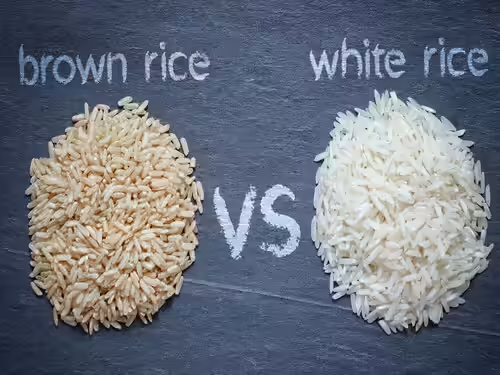Is Brown Rice Really Better for You Than White Rice? The Science Explained

For decades, the debate between brown rice and white rice has divided nutrition experts, dietitians, and fitness enthusiasts alike. Some swear by brown rice as the healthier, more nutrient-dense choice. Others argue that white rice, being easier to digest and more palatable, isn’t the dietary villain it’s made out to be.
So, which one truly deserves a place on your plate? Let’s break down the science behind these two staple grains—examining everything from nutrient content and glycemic index to their effects on digestion, metabolism, and chronic disease risk.
Understanding the Basics: What’s the Difference Between Brown and White Rice?
Both brown and white rice come from the same plant—Oryza sativa. The key difference lies in how much of the grain’s outer layers are removed during processing.
- Brown Rice: It is a whole grain, meaning it retains all three parts of the kernel—
- Bran: The fiber-rich outer layer that contains antioxidants and B vitamins.
- Germ: The nutrient-packed core with healthy fats, vitamins, and minerals.
- Endosperm: The inner starchy portion that provides carbohydrates and some protein.
- White Rice: It undergoes milling that removes the bran and germ, leaving only the endosperm. This process improves shelf life and gives it a softer texture but strips away much of its nutritional value.
This structural difference explains why brown rice is often touted as the healthier option—it’s less processed and retains more natural nutrients.
Nutritional Comparison: Brown vs. White Rice
Let’s look at the key nutrient differences in one cup (about 195 grams) of cooked rice:
| Nutrient | Brown Rice | White Rice |
| Calories | 218 | 205 |
| Carbohydrates | 45g | 45g |
| Fiber | 3.5g | 0.6g |
| Protein | 5g | 4.3g |
| Fat | 1.6g | 0.4g |
| Magnesium | 84mg | 24mg |
| Phosphorus | 150mg | 68mg |
| Potassium | 154mg | 55mg |
| Vitamin B1 (Thiamine) | 0.2mg | 0.07mg |
| Vitamin B3 (Niacin) | 3mg | 2.3mg |
| Selenium | 19mcg | 9mcg |
Takeaway:
Brown rice clearly contains more fiber, minerals, and vitamins. Its higher magnesium and selenium levels are particularly beneficial for metabolic and immune health. However, white rice isn’t completely devoid of nutrients—especially when it’s enriched (fortified with added vitamins like iron and folate), which is common in many countries.
The Role of Fiber: Why It Matters
Fiber is one of the most significant nutritional advantages brown rice has over white rice.
Benefits of Fiber in Brown Rice
- Improved Digestion: Fiber adds bulk to stool, promoting regular bowel movements and preventing constipation.
- Blood Sugar Regulation: It slows the absorption of glucose, helping maintain stable blood sugar levels.
- Satiety and Weight Control: Fiber makes you feel full longer, which can reduce overeating.
- Heart Health: Studies show that higher fiber intake can lower LDL (“bad”) cholesterol and reduce cardiovascular risk.
In contrast, white rice contains very little fiber, meaning it’s digested and absorbed much faster—leading to rapid spikes in blood sugar and insulin levels.
Glycemic Index: A Key Factor in Blood Sugar Control
The glycemic index (GI) measures how quickly a food raises blood glucose levels after eating.
- White rice generally has a high GI (70–89 depending on the type), meaning it causes a sharp rise in blood sugar.
- Brown rice, on the other hand, has a moderate GI (50–55), leading to a slower, more stable glucose release.
For individuals with diabetes or insulin resistance, this difference is crucial. Research published in the journal Diabetes Care found that replacing 50 grams of white rice per day with brown rice was associated with a 16% lower risk of developing type 2 diabetes.
However, it’s not just the color of rice that affects blood sugar—the cooking method matters too.
- Cooling cooked rice and then reheating it increases resistant starch, a form of carbohydrate that behaves like fiber and reduces GI.
- Pairing rice with protein, fat, or vegetables also helps slow sugar absorption.
Micronutrients and Antioxidants: What the Research Shows
Brown rice contains more naturally occurring antioxidants, particularly in the bran layer. These include:
- Phenolic acids – combat inflammation and oxidative stress.
- Flavonoids – support heart and liver health.
- Gamma-oryzanol – may reduce cholesterol absorption.
A study in the Journal of Food Science and Technology found that brown rice has up to 3 times more antioxidants than white rice.
Moreover, the magnesium in brown rice supports energy metabolism, bone health, and nerve function—nutrients often lacking in processed diets.
White rice, while less nutrient-dense, is sometimes fortified with synthetic vitamins and minerals. In many countries, enriched white rice contains added iron, folic acid, and B vitamins to compensate for processing losses—beneficial for preventing deficiencies, especially during pregnancy.
Digestibility and Sensitivity: When White Rice Might Be Better
While brown rice is more nutritious, it’s not necessarily better for everyone. Its higher fiber content and phytic acid (an anti-nutrient found in the bran) can make it harder to digest for some individuals.
Who Might Prefer White Rice:
- People with digestive issues: Those with irritable bowel syndrome (IBS), Crohn’s disease, or chronic bloating may tolerate white rice better.
- Athletes and bodybuilders: During intense training, quick-digesting carbs from white rice can rapidly replenish glycogen stores.
- Infants and the elderly: White rice’s soft texture and low fiber make it easier to chew and digest.
Phytic Acid Concern:
Phytic acid in brown rice binds minerals like zinc, calcium, and iron, reducing their absorption. However, soaking or lightly fermenting brown rice before cooking can neutralize some of this compound, improving digestibility.
Arsenic Levels: The Controversial Downside of Brown Rice
One of the biggest concerns surrounding brown rice is its arsenic content. Arsenic, a toxic heavy metal found in soil and water, accumulates more in brown rice because it’s stored in the bran layer—the part removed during white rice processing.
Long-term arsenic exposure has been linked to increased risks of:
- Heart disease
- Cancer
- Developmental issues in children
Minimizing Arsenic Exposure
To reduce arsenic levels:
- Rinse rice thoroughly before cooking.
- Cook using the “excess water method” (use six cups of water per one cup of rice, then drain the excess).
- Rotate grains—include quinoa, millet, or barley in your diet instead of relying solely on rice.
While brown rice offers nutritional benefits, moderation is key, especially for children and pregnant women.
Heart Health and Metabolic Effects
Several studies have highlighted the heart-protective benefits of brown rice.
- A 2016 study in Nutrition & Metabolism showed that individuals consuming brown rice regularly had lower LDL cholesterol and triglycerides compared to those eating white rice.
- Its higher fiber, magnesium, and antioxidant content contribute to reduced inflammation and improved vascular health.
White rice, when eaten in large quantities (particularly refined and unfortified varieties), has been associated with higher risks of metabolic syndrome in some populations. However, in Asian countries where rice is part of a balanced diet rich in vegetables and fish, white rice consumption hasn’t shown the same adverse effects—suggesting that overall diet quality matters more than rice type alone.
Weight Management: Which Rice Supports a Healthier Body Weight?
Brown rice may help with weight control due to its fiber and slower digestion rate.
- A study published in The American Journal of Clinical Nutrition found that participants who replaced white rice with brown rice for 12 weeks experienced modest weight loss and better waist circumference reduction.
- The increased satiety from brown rice means fewer calories consumed over time.
However, portion control is still essential. Even brown rice is calorie-dense, and large servings can lead to excess calorie intake if not balanced with other food groups.
White rice, though lower in fiber, isn’t inherently “fattening.” It depends largely on portion size and what you pair it with. When combined with lean proteins, vegetables, and healthy fats, it can be part of a balanced, weight-friendly diet.
Cultural and Culinary Perspectives
It’s worth noting that rice plays a cultural and culinary role far beyond its nutritional profile.
- In Asia, Latin America, and parts of Africa, rice is a staple that feeds billions.
- Many traditional dishes—like sushi, biryani, or paella—depend on the texture and flavor of white rice.
While health trends often favor “whole grains,” cultural food traditions shouldn’t be dismissed. Nutrition is not just about nutrients—it’s also about sustainability, satisfaction, and enjoyment.
For some, switching entirely to brown rice may feel unfamiliar or unappealing. A gradual approach, such as mixing white and brown rice or alternating between them, can offer the best of both worlds.
Cooking and Preparation Tips
For Brown Rice:
- Soak for 30–60 minutes before cooking to reduce phytic acid and improve texture.
- Use a 1:2.5 rice-to-water ratio for softer grains.
- Try adding broth, herbs, or olive oil to enhance flavor.
For White Rice:
- Rinse thoroughly to remove excess starch and reduce arsenic levels.
- For a healthier version, pair it with fiber-rich vegetables and protein sources like beans or chicken.
- Experiment with varieties like basmati or jasmine rice, which have slightly lower GI values.
Both rice types can be part of a nutrient-balanced plate when combined with vegetables, lean proteins, and healthy fats.
The Verdict: Which Rice Should You Choose?
So—is brown rice really better for you than white rice?
The answer depends on your health goals, digestive tolerance, and overall diet quality.
Choose Brown Rice If:
- You want more fiber, vitamins, and minerals.
- You’re managing diabetes or looking to control blood sugar.
- You aim to improve heart health or lose weight gradually.
Choose White Rice If:
- You have digestive sensitivities or gut issues.
- You need quick energy or faster digestion (e.g., athletes).
- You’re eating fortified white rice and maintaining a nutrient-rich overall diet.
Ultimately, both types can fit into a healthy diet when eaten in moderation and prepared thoughtfully. What matters most is the balance of your meals and the diversity of your grains.
A Balanced Approach: Mix, Match, and Moderate
For most people, the best approach isn’t choosing one over the other—it’s combining them.
- Mix white and brown rice for a better texture and nutrient balance.
- Rotate with other grains like quinoa, bulgur, barley, or farro to diversify your diet.
- Focus on whole-food meals rather than single ingredients—rice is just one piece of the puzzle.
Final Thoughts: What Science Truly Says
The science is clear:
- Brown rice provides more fiber, micronutrients, and antioxidants.
- White rice, especially when enriched, is easier on the stomach and not necessarily “unhealthy.”
- Long-term health outcomes depend more on overall dietary patterns than on whether your rice is brown or white.
In other words, both can be healthy choices—depending on how you cook, serve, and balance them within your lifestyle.
So the next time you’re at the dinner table facing a bowl of rice, remember: it’s not about the color of the grain—it’s about the context of your meal and the consistency of your habits.
Whether you choose brown for its nutrient density or white for its comfort and digestibility, science suggests that moderation, mindfulness, and variety remain the ultimate recipe for health.




